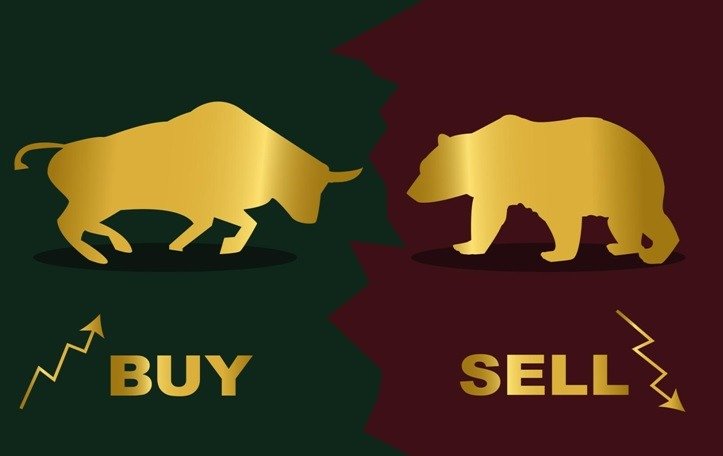Since the crypto market is very unpredictable and volatile, even experienced traders cannot always predict what will happen to a particular coin in the future.
The volatility of the market allows you to make huge profits on the rise in coin rates. However, sometimes a decrease in the market value of assets brings no less profit. Many cryptocurrency traders prefer this strategy for earning during periods of market weakness. Moreover, the decline usually occurs much faster than growth.
Let’s figure out how to make money on the fall of cryptocurrency
Cryptocurrency Trading Basics: Where It All Begins
The first is a gradual increase in the position during a decline with the aim of subsequent sale when the trend changes.
This method of successive purchases at lower and lower levels is also called “averaging”. This is the most accessible option for a bearish game, suitable for most medium- and long-term investors. Its essence is simple: each time you buy coins at an increasingly favorable price, thereby reducing their average cost. For example, in December 2017, the price of Bitcoin reached $18 thousand, and then fell to 13. During the short-term correction phase, traders were able to buy coins at successive levels: 17,000, 16,000, 15,000, 14,000 and 13,000. This means that the average purchase price was $15,000.
After a short rest, the leader jerked up again — quickly returned to the initial mark of $18,000 and even surpassed it. Thus, the game on the cryptocurrency exchange, associated with a decline during the market collapse, allowed to get about $3,000 (18,000-15,000) from each bitcoin. This strategy for trading bitcoins and other coins is available to almost any trader, since it is not much more difficult than traditional trading tactics. The main thing is to correctly determine the stage of correction, successfully enter it and sell assets at the beginning of the next stage of growth.

Investors who are just learning cryptocurrency trading probably have a question: if the price eventually reaches $13,000, why buy coins at every level of decline? The answer is obvious – even a professional cannot accurately predict how much the value of an asset will decrease. After a correction to 17,000, it can go up again, so do not be lazy in buying cryptocurrency at all stages. If the time of entry into a position is determined correctly, the difference between the average and maximum rates will still bring profit.
This was the most accessible way of playing for a fall, but there is a more complex option – short cryptocurrencies.
Cryptocurrency Trading Strategy: Shorting
The second strategy for trading cryptocurrency, which is more risky, is based on the use of short, or short positions.
The name SHORT has nothing to do with the duration of the trades, but short positions are not typically held for months.
On stock exchanges, asset sales transactions were fleeting – carried out as quickly as possible before the currency became cheaper. That’s why they were called “short”, which means “short” in English. A purchase transaction, on the contrary, took longer to acquire an asset at the most favorable price. Then, strategies came from the traditional market to cryptocurrency trading.
As for shorting itself, everything is much more complicated. This is a strategy in which a user expecting a coin to fall in value opens a sell position, but without buying up assets at price decline levels.
By opening a short position, a trader borrows cryptocurrency and sells it on the market at the current price (for example, selling Bitcoin at $48,000). After the price has dropped, the trader buys back the cryptocurrency at a lower price ($44,000) and makes a profit on the difference between the purchase and sale price.
First of all, you need to remember that “short” is already margin trading on a cryptocurrency exchange, i.e. you borrow funds from a broker, and this gives rise to several new serious features and rules for trading:
Your funds in the account cover the “margin”, i.e. your deposit ensures the maximum deviation of the value of your position. In other words, if the position you opened becomes cheaper by the amount of your deposit (in the case of a “short” the price starts to rise), the position will be automatically closed and you will lose everything;
The downward movement in this cryptocurrency trading strategy is limited to 100% (if the token in the “short” depreciates), unlike the upward movement, which has no potential for multiple growth;
You work in margin crypto trading, i.e. you can open a position 5, 10, 20 and even 125 times more than you have funds in your account. But do not forget – if something goes wrong, you will lose everything. Therefore, even “with leverage” we do not recommend investing more than your deposit, i.e. with 10-fold leverage, invest no more than 10 percent of your deposit – this will avoid a “margin call”, a situation in which the online cryptocurrency exchange offers to immediately replenish your account to increase the collateral, or it will automatically close the risky position and the entire deposit will be lost.
When using “short” positions in trading, you should remember another simple rule: even if the value of the cryptocurrency has fallen by 2 times, you will earn no more than 50%, while if the price increases by 2 times, the losses will be 100%. Thus, extreme caution is required in such a “game for a fall”, because the cryptocurrency market has repeatedly surprised even experienced traders with the rapidity of changing trends.

Of the two cryptocurrency trading strategies above, the first is easier to use and is suitable for most medium-term and long-term investors. However, many of them, observing another decline in the market, are afraid that if the price falls for too long and drops to the minimum level, it may happen that the cryptocurrency trader will not be able to sell coins to anyone. I must note that at the current stage of market development (millions of cryptocurrency users, dozens of large exchanges, the presence of market makers and institutional investors), such a situation is unlikely. No matter how long the period of price decline was (and for Bitcoin alone, history has more than 10 long falls), the correction sooner or later ended and the price reached its next maximum.
How to Trade Properly: The Profits of Shorting Bitcoin
Shorting is considered a very effective strategy for trading cryptocurrencies, but at the same time it is more risky compared to long-term investments and averaging.
However, beginners should not short Bitcoin and work with big money, since the ability to correctly analyze the dynamics of cryptocurrencies and enter the market with a clearly defined downward trend is important here. Remember: even if the value of a coin has fallen by half, your profit will not exceed 50%, and if it grows, you will lose everything. Extreme caution is required when playing for a fall, because the cryptocurrency market has repeatedly surprised with its unpredictability.
Inexperienced investors are better off playing for the decline of “calm” altcoins, but first it would be a good idea to practice averaging. With a competent approach, such a cryptocurrency trading strategy also brings a good income, and in addition helps to study the mechanisms of cryptocurrency price formation.
So, as we see, you can make money even on a falling market. It is enough to choose a well-known coin and study the history of its rate changes in order to buy it before it stops falling and sell it after a sharp price jump. To do this, you need to track cryptocurrency market news and analyze the price dynamics of the asset.
It is not always that a bearish game turns out to be unprofitable due to the lack of experience of the trader. Often the forecast does not come true due to the activity of large market participants. They know when most investors open short positions and use this for their own benefit, manipulating the rate.
An experienced trader must remember that there are only two possible outcomes on the market: the price either rises or falls.
The above information is not financial advice, but merely a reminder of important strategies for playing on the cryptocurrency exchange.
Автор Evgeniy
IT entrepreneur. I consult the Buycrypt team on organizing a decentralized economy. I develop a strategy for bringing the token's value proposition to the market. I work on mathematical models: - increasing the efficiency of fund trading using the method of collective decision-making. - trader's IQ for weighing the impact on a collective decision. - calculating the fairness of income and contribution distribution. - predictive algorithm based on mass reactions. - decision-making system and organization of input/output of assets.
